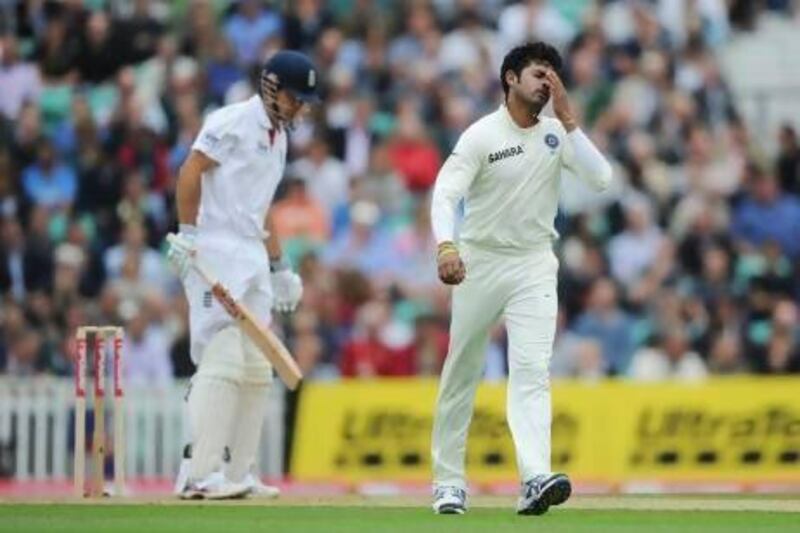It was just over seven years ago. Sitting by the backwaters in Kochi, Greg Chappell spoke at length about young players and the stresses involved in the step up from domestic cricket.
"It's not the techniques you worry about so much as the other factors," he said.
"In a country like India, the pressure of expectation is immense. It's not enough to be physically and mentally fit. You need a lot of emotional maturity as well to deal with the ups and downs."
He was talking primarily about MS Dhoni, who had been pilloried in many quarters for his shot selection in a Test defeat to England in Mumbai.
But one of the other names he mentioned often was Sreesanth, who had made his debut during the series and shown glimpses of what a fine swing bowler he could be.
Better than any other coach, Chappell knew how to manage Sreesanth, even if some of the conversations were similar to those you'd have with a toddler.
"Are you going to be good Sree or bad Sree?" he would ask, while urging him to cut down on the histrionics and focus on a fourth-stump line.
At the Wanderers in Johannesburg later that year, where match figures of eight for 99 inspired India to a first win on South African soil, he was undoubtedly good Sree.
But too often down the years, the bad or the eccentric has outweighed the good, making him a peripheral figure in both Test and limited-overs sides.
What the Delhi police commissioner spoke of yesterday afternoon went beyond bad, to embrace the cynical and the corrupt.
If the allegations of spot-fixing in the Indian Premier League are true, what should have been a stellar career is almost certainly over.
People will forget about Ajit Chandila and Ankeet Chavan - the two others involved in the allegations - soon enough, but they will be speaking of Sreesanth in the same breath as Mohammad Amir, Mohammad Asif and Salman Butt - in Hall of Shame terms.
At his news conference, N Srinivasan, the president of the Board of Control for Cricket in India, said that anti-corruption measures were in place, but that it was impossible to keep tabs on every single player.
He is right.
More than 200 players have taken part in this IPL season, and you cannot shadow their every movement, or monitor every phone call or text message.
What they could do is get rid of the apartheid-like divisions between players. If you have won international honours, even if it is only one cap, you are part of a lucrative auction process.
If you are uncapped, your salary is capped at a nominal amount. As a result, players like Saurabh Tiwary and Manpreet Gony, who got their 15 minutes on the international stage, have made millions, while those with far more talent have to settle for US$60,000 (Dh220,380).
Players and franchises alike have been flouting that rule for years. Under-the-table payments and other inducements - convertible cars and apartments - are rife, but they still do not remove the sense of injustice that many uncapped players feel.
It doesn't help that vultures often surround them, either.
Unlike in England, Australia and South Africa, where most player agents run legitimate, respectable businesses, many in India still function in Mazhar Majeed-like fashion.
Often, at games and team hotels, you will come across individuals who claim to be representing X or Y.
These "facilitators" are often the conduit between players and those seeking to influence games.
Without players' organisation or guidance that is taken seriously, it is hard to keep such dodgy elements at bay.
After the first edition of the IPL, its governing council had announced that the National Cricket Academy in Bangalore would introduce a mentoring programme to help young players.
Five years on, we are yet to see it.
Spot-fixing is appealing because it promises relatively big rewards for little effort.
You do not need the cooperation of your teammates to bowl three long hops or full tosses. And most people are unlikely to see anything sinister in a hand towel sticking out of a trouser pocket before the start of an over.
In a league where the likes of Chris Gayle and David Miller routinely hammer in excess of 20 runs an over, few eyebrows will be raised if a bowler goes for 14 in one. Had the Delhi police not stumbled on the betting ring, we would be none the wiser.
Ultimately, though, fixing of any kind is about greed. From the Chicago Black Sox baseball scandal that followed the first World War, it always has been. You can blame boards and the lack of mentors up to a point.
But as Sourav Ganguly pointed out, no one can forsee which player could be corrupt. Bad Sree could have been Good Sree.
Follow us
[ @SprtNationalUAE ]





